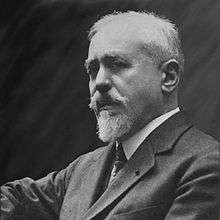Symphony in C (Dukas)
The Symphony in C is a symphony by the French composer Paul Dukas, dedicated to fellow musician Paul Vidal.
The symphony was written in 1896, when Dukas was 30, and was premiered on January 3, 1897, with Paul Vidal conducting.[1] It is written for a standard orchestra comprising three flutes (the third doubling piccolo), two oboes (the first doubling cor anglais), two clarinets in B-flat and A, two bassoons, four French horns in F (third and fourth also in E), two trumpets in F, piccolo trumpet in D, three trombones, tuba, timpani, and strings.
Like César Franck's only symphony, Dukas' is in three movements rather than the conventional four:
- Allegro non troppo vivace, ma con fuoco, C major, 6/8
- Andante espressivo e sostenuto, 4/8, E minor, C major, B major, E minor
- Finale. Allegro spiritoso, C major, 3/4 = 9/8
The first movement is a sonata form allegro with three themes. The second movement is also in sonata form, but only with two themes. The finale is an ABACA rondo.
The symphony has been described as a "charming and colorful work."[2]
References
- p. [blank] (1993) Inoue
- p. 65, Trotter (2003) William R. New York Priest of Music: The Life of Dimitri Mitropoulos Amadeus Press
- Inoue (1993) Satsuki. Denon CO-75284 Thompson (translator) Robin. Nippon Columbia Co. Ltd. Japan
Further reading
- Deruchie, Andrew. 2013. The French Symphony at the Fin de Siècle. New York: University of Rochester Press. ISBN 978-1-58046-382-9. Chapter 7.
External links
| Wikimedia Commons has media related to Paul Dukas. |
- Symphony in C (Dukas): Scores at the International Music Score Library Project (IMSLP)
